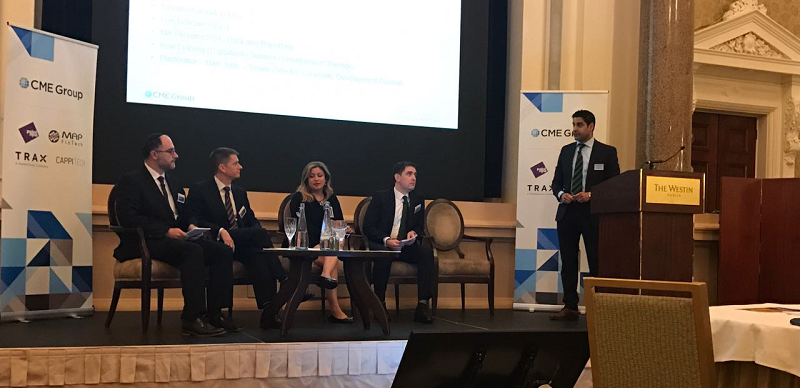
Preparing for MiFID II? It’s all about what’s under scope and data, data, data
What are the two biggest topics for the EU financial industry at the moment? Attending the CME Group’s Regulation Conference in Dublin last week, the clear answer is MiFID II and to a lesser extent Brexit.
Article 50 was officially submitted to the EU yesterday, starting the two-year countdown to Brexit. For the financial industry, this means a new waiting period to see what treaties are signed between the UK and EU.
The agreements will answer questions of equivalence and passporting that will shape how firms and investors between the EU and UK work together. However, despite the expected major ramifications of Brexit, it may still be some time before the financial industry has a better understanding of what preparations will be required to move forward.
 |
|
(L to R) Ron Finberg (Cappitech), Len Delicaet (TRAX),
Nirvana Farhadi (Hitachi Data Systems),
Ian Sloyan (ISDA), Daniel Jude (CME Group) |
MiFID II – scope and data
Moving to MiFID II, the coming regulation was cited on numerous occasions by presenters and keynote speakers at the conference. I had the chance to participate in the afternoon Regulatory Reporting panel that focused on MiFID II. Moderated by Daniel Jude from the CME Group, joining us on the panel were Nirvana Farhadi from Hitachi Data Systems, Ian Sloyan from the ISDA and Len Delicaet from Trax Markets.
Takeaways from the panel:
What’s under scope – It may seem obvious, but iterated several times was the need for financial firms to first understand what part of their operations are under scope for MiFID II and what type of reporting that entails. Feedback from panelists is that they are often encountering existing and potential clients that are asking about MiFID II solutions and how to report without knowing what they should do to comply with the regulation.
Data, data, data – After clarifying scope, the next key item to consider is data. MiFID II regulation at its foundation is a huge data play. Whether its real-time trade reporting to an APA, creating Best Execution reports or standardizing information funds have to provide clients, each of these portions of MiFID II regulation apply the extraction of data to create a new report. As a result, to comply with MiFID II it is an important to understand how related trade data is being stored and how it can be extracted to create reports.
An example cited during the panel are fund companies that are using multiple fund managers and systems to book trades. To properly comply with MiFID II, a strategy needs to be in place to aggregate the trades and normalize the data to create a report.
Also, discussed are security concerns. Part of MiFID II reports include requirements for personal ID details of both traders and clients. Financial firms, especially brokers, will now need to balance securing client data while also being flexible with allowing this information to be accessed for reports.
 The good news, is that there are technology solutions being created to increase data efficiency. They include systems of which their main task is to aggregate and normalize files from numerous destinations. Also, ARMs are developing methods where financial firms where client details can be housed as reference data and doesn’t need to be submitted on a daily basis.
The good news, is that there are technology solutions being created to increase data efficiency. They include systems of which their main task is to aggregate and normalize files from numerous destinations. Also, ARMs are developing methods where financial firms where client details can be housed as reference data and doesn’t need to be submitted on a daily basis.
Everything else – Beyond scope and data, the next step is making a decision of building products in-house to comply with MiFID II, working with external vendors such as Cappitech who specialize in regulatory reporting, or some sort of hybrid.
The perfect end to an afternoon of discussing regulation
According to the panel, the answer is very much a company by company decision. Firms that are technology first may have a preference to create MiFID II solutions in-house as they best know how to integrate them with their existing systems. However, for many other firms, dealing with MiFID II compliance is a distraction. Therefore, outsourcing allows them to focus on other areas of their operations that they excel at.





